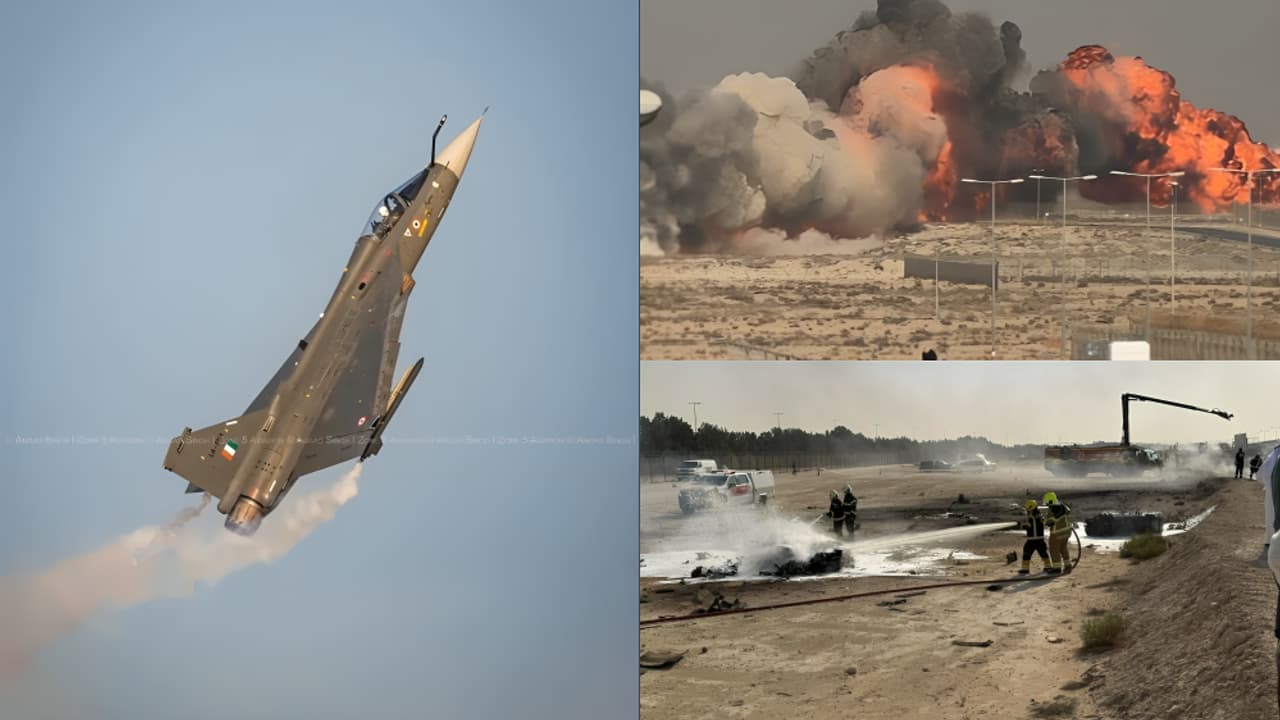Experts say the Tejas fighter jet that crashed at the Dubai Airshow may have been attempting a barrel-roll manoeuvre when it lost height and speed, leaving no room to pull up. The IAF confirmed the pilot died in the crash.
The fatal crash of an Indian Air Force (IAF) Tejas fighter jet on Friday at the Dubai Airshow 2025 has raised one major question across aviation circles and among the public: what exactly went wrong in the final seconds before the jet plunged to the ground? Experts studying videos say the aircraft appeared to be attempting a loop-style or barrel-roll manoeuvre when it suddenly lost balance. This tragic incident also came just a day after the Indian government dismissed viral claims that the Tejas Mk1 had suffered an ‘oil leak’ at the show.
Scroll to load tweet…
How the crash unfolded at the Dubai Airshow
The crash happened around 2:10 pm local time on Friday at the Al Maktoum International Airport, where the biennial Dubai Airshow was taking place. The Tejas was performing an aerial demonstration before a large crowd. Spectators and local media reported that the aircraft was flying low, pulled up for a manoeuvre and then suddenly lost control.
Black smoke rose from the crash site as emergency vehicles rushed in. The show was temporarily halted, and visitors were sent back to the exhibition area.
Local media, including Gulf News and Khaleej Times, said the fighter appeared to crash shortly after take-off. One eyewitness said, “As soon as the plane took off, it crashed. I am not sure which aircraft it was.” Another eyewitness said the area was cleared within 45 minutes.
Dubai Media Office confirmed the death of the pilot, adding that emergency teams acted quickly. The Indian Air Force confirmed the crash and the death of the pilot in a statement posted on X:
“An IAF Tejas aircraft met with an accident during an aerial display at Dubai Air Show, today. The pilot sustained fatal injuries in the accident. IAF deeply regrets the loss of life and stands firmly with the bereaved family in this time of grief.”
The IAF said a court of inquiry has been ordered to determine the exact cause. Chief of Defence Staff General Anil Chauhan also expressed deep regret over the loss of life.
Experts decode the final manoeuvre
A detailed video study by aviation experts, as reported by India Today, suggests the pilot may have been attempting a barrel roll or a loop-type manoeuvre. This manoeuvre involves the aircraft climbing, rolling inverted, descending while still rotating, and then pulling up again to complete the roll. The manoeuvre is said to be risky at low altitude as the experts say:
- The Tejas climbed and went inverted as expected.
- But when it began descending, it came too close to the ground.
- The jet did not have enough height to pull up again.
- It also seemed to lack the required speed to complete the roll safely.
During a barrel roll, the pilot is briefly upside down before the aircraft completes the full axial rotation. Even though this manoeuvre is not considered extremely complex, it is still demanding in a fast fighter jet, and even a small misjudgement of height or speed can be fatal.
Possible engine flameout also being discussed
While experts have discussed the possibility of a miscalculated manoeuvre, some have also mentioned a potential engine flameout. The Tejas uses an American-made General Electric engine, though the aircraft itself is designed and developed in India by Hindustan Aeronautics Limited (HAL) and the Aeronautical Development Agency (ADA).
The IAF, however, has not confirmed any specific technical reason yet.
The Tejas jet’s safety record
According to defence journalist Sandeep Unnithan, as quoted by India Today, more than 40 Tejas aircraft have flown in the past 24 years, and this crash is only the second involving the Light Combat Aircraft.
Experts note that the fighter has maintained a ‘near-perfect’ safety record over its long development and operational life. The Tejas is India’s first home-grown fighter jet and is crucial for the IAF as it replaces the ageing MiG-21 fleet.
A day earlier, govt debunked viral claim of Tejas ‘oil leak’
Interestingly, the crash took place just one day after the Indian government issued a fact check against widely shared posts claiming the Tejas Mk1 had suffered an oil leak at the Dubai Airshow. PIB Fact Check said:
- The videos were not showing an oil leak.
- They showed routine draining of condensed water from the aircraft’s Environmental Control System and On-Board Oxygen Generating System.
- This draining is standard procedure for aircraft in humid climates like Dubai.
- The viral claim was labelled fake and called a deliberate attempt to spread misinformation about the jet’s reliability.
The Dubai Media Office confirmed emergency teams and firefighters reached the crash site within minutes. Operations were managed quickly, and the area was secured.
The Dubai Airshow, hosting more than 1,500 exhibitors, began on 17 November and was scheduled to run till 24 November.
Scroll to load tweet…
The crash of the Tejas fighter jet has led to deep sorrow in India and the aviation community. As the IAF begins its investigation, experts continue to study the video closely to understand exactly what went wrong in those last few seconds. The Tejas remains a key part of India’s defence future, and the findings of the inquiry will be watched very closely.
(With inputs from agencies)
